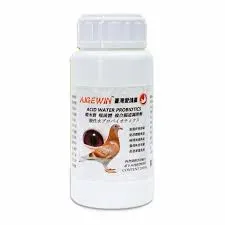
اکتبر . 06, 2024 04:57 Back to list
staphylococcus
Understanding Staphylococcus A Closer Look at a Versatile Bacterium
Staphylococcus is a genus of bacteria that has garnered significant attention in the fields of microbiology and medicine due to its role in various infections and its unique characteristics. These Gram-positive cocci are commonly found in the human body and the environment, displaying remarkable versatility and adaptability. In this article, we will delve into the biology of Staphylococcus, its pathogenic strains, and the implications for human health.
Taxonomy and Characteristics
Staphylococcus belongs to the family Staphylococcaceae and is characterized by its spherical shape, often appearing in clusters resembling grapes. Microscopic examination reveals their arrangement, which is a key identifier in laboratory settings. The genus comprises several species, with Staphylococcus aureus being the most clinically relevant due to its pathogenecity.
Staphylococcus is catalase-positive, enabling it to break down hydrogen peroxide, a trait that distinguishes it from Streptococcus species. This capability gives Staphylococcus a survival advantage in aerobic environments. Additionally, these bacteria can tolerate high salt concentrations, making them resilient in the human skin and other challenging habitats.
Pathogenic Strains and Infections
Understanding Staphylococcus A Closer Look at a Versatile Bacterium
Other notable pathogenic species include Staphylococcus epidermidis, which is typically part of the skin flora but can cause infections, particularly in immunocompromised individuals or those with implanted medical devices. This species is often associated with biofilm formation, leading to persistent infections that are difficult to treat.
staphylococcus

Mechanisms of Virulence
Staphylococcus employs various strategies to establish infections and escape the immune response. One such mechanism is the production of surface proteins that facilitate binding to host tissues. Additionally, Staphylococcus produces a range of toxins and enzymes that contribute to its virulence. For example, cytolytic toxins damage host cell membranes, while proteases can degrade host immune factors, thereby blunting the immune response.
Biofilm formation is another critical factor in the virulence of some Staphylococcus species. Once attached to surfaces, these bacteria can produce a polymeric matrix that protects them from both the host immune system and antibiotic treatment. This phenomenon is particularly concerning in patients with implanted medical devices, as it can lead to chronic infections that require extensive medical intervention.
Clinical Implications and Treatment Challenges
The rise of antibiotic-resistant strains of Staphylococcus poses significant challenges for healthcare providers. The emergence of MRSA and other resistant strains has led to increased morbidity and healthcare costs. Treatment often requires a multifaceted approach, including the use of alternative antibiotics, surgical interventions, and, in some cases, the removal of infected devices.
Prevention is equally important in managing Staphylococcus infections. Proper hygiene, wound care, and responsible antibiotic use are crucial in reducing the spread of these bacteria. Healthcare settings have implemented strict infection control measures to prevent outbreaks, particularly in high-risk populations.
Conclusion
Staphylococcus is a fascinating and complex genus of bacteria that plays a dual role in human health, being both a benign inhabitant and a formidable pathogen. Understanding its biology, pathogenic mechanisms, and the challenges it presents is essential for the advancement of medical science and public health. As antibiotic resistance continues to rise, ongoing research and innovative treatment strategies will be crucial in combating Staphylococcus-related infections and safeguarding human health. Through education and awareness, we can mitigate the risks associated with this versatile bacterium and promote a healthier future.
-
Quality Bacillus Coagulans BC30 Factory - Expert Production
NewsAug.02,2025
-
China Salivation AI with GPT-4 Turbo Features
NewsAug.01,2025
-
Epic Sepsis Factories: AI-Driven Detection with GPT-4 Turbo
NewsJul.31,2025
-
Acute Salpingitis and Oophoritis AI Factory
NewsJul.31,2025
-
Premium China Bacillus Subtilis Supplier & Factory Solutions
NewsJul.30,2025
-
Premium Avermectin Supplier in China | Custom Solutions Available
NewsJul.29,2025




